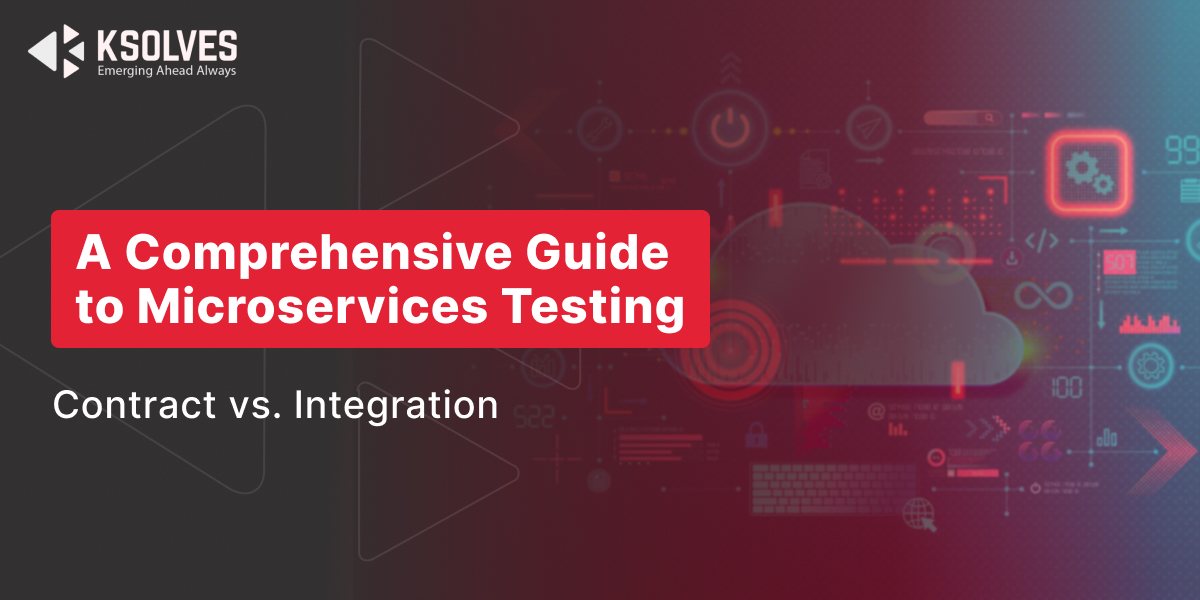A Comprehensive Guide to Microservices Testing: Contract vs. Integration
Microservices
5 MIN READ
May 7, 2024
![]()

Testing is one of the crucial factors affecting the quality of the software and the experience it delivers to the consumers. Therefore, companies and development teams employ various techniques to optimize quality.
Testing becomes even more important in microservices architecture, where applications comprise tiny, autonomous services. Microservices testing ensures that every service works properly independently and when integrating with other services.
A large, complex application can be broken into smaller, independent services that communicate with one another over a common API, a technique known as microservices architecture. Programming interfaces, or APIs, provide data sharing and task execution as well as communication between apps.
Microservices Testing: Contract vs. Integration
Two fundamental approaches in microservices testing are contract testing and integration testing. The goal of contract testing is to confirm that each microservice complies with its specified interfaces and behaviors by examining the agreements, or contracts, between the services. Conversely, integration testing verifies the relationships and interdependencies among various microservices, guaranteeing smooth communication and comprehensive system functionality from beginning to end.
In this comprehensive guide, we’ll delve into both methodologies, exploring their significance, differences, and when to use each.
Understanding Contract Testing
In the domain of testing microservices, understanding the importance of validating contracts is essential. Contract testing operates as a foundational practice in guaranteeing the dependability and scalability of microservices architectures. It provides a complete guide for testing microservices, focusing on verifying the agreements (contracts) that define the expected behavior and data formats exchanged between services. Unlike traditional integration testing methods, contract testing allows for isolated testing of individual services, independent of the entire system’s state. This approach promotes service independence and early issue detection, crucial aspects in agile development environments.
Contract testing is a vital component of microservices testing, focusing on verifying the agreements (contracts) between individual services. To ensure smooth system communication, these contracts specify the expected behavior and data formats shared across services.
By emphasizing the importance of testing contracts in microservices architecture, organizations can build resilient and scalable systems. Contract testing facilitates rapid iteration and deployment of services, minimizing the risk of compatibility issues and regressions. It accelerates the development lifecycle by enabling developers to iterate and evolve services autonomously while ensuring seamless communication within the system. Therefore, incorporating contract testing into microservices testing strategies is essential for achieving concentrated and reliable architectures.
Read More: Top 5 Best Technologies to Build Microservices Architecture
Key Aspects of Contract Testing:
1. Service Independence
Services can develop separately without being closely coupled to one another thanks to contract testing. The autonomy of each service in terms of development, deployment, and scaling promotes flexibility and agility in microservices architecture.
2. Consumer-Driven Contracts
Customers of a service define the contracts they anticipate from providers through contract testing. By ensuring that provider modifications do not unintentionally deviate from customer expectations, this method—known as consumer-driven contracts—improves compatibility and lowers regressions.
3. Early Detection of Issues
Contract testing makes it easier to identify inconsistencies or breaking changes early on by independently verifying contracts. Early in the development lifecycle, any deviations from the established contracts can be recognized and rectified, reducing downstream failures and speeding delivery.
4. Isolated Testing
Contract testing removes the need for intricate test configurations requiring numerous dependencies by enabling the isolation testing of specific services. As a result, testing processes are made simpler, feedback cycles are accelerated, and overall development efficiency is improved.
Read More: 5 Essential Design Patterns For Robust & Scalable Microservices
Consider using contract testing:
- For microservices requiring independent evolution.
- When a service is utilized by multiple consumers, precise contracts to ensure compatibility.
- In situations where early issue detection is vital to prevent downstream failures.
- When isolated testing of individual services is necessary to confirm contract adherence.
Understanding Integration Testing:
Integration testing is an essential aspect of providing the seamless functioning of microservices architectures. Unlike contract testing, which ascertains individual service contracts, integration testing assesses how multiple microservices interact and cooperate within the broader system context. This testing methodology scrutinizes the interdependencies between services, validating end-to-end functionality and data flow across the entire system.
Integration testing in microservices architectures has its own set of challenges. One noteworthy challenge is addressing the complexity of interconnected services, as changes in one service can have ripple effects across the entire system. Additionally, producing test environments and dependencies, ensuring data consistency, and maintaining test coverage across diverse microservices pose logistical challenges for testing teams.
Despite challenges in microservices integration testing, it remains indispensable for validating the resilience, scalability, and interoperability of microservices-based systems. By leveraging specialized tools and best practices, organizations can overcome the complexities of integration testing and build robust, reliable, and scalable microservices architectures.
Key Aspects of Integration Testing:
1. End-to-End Scenarios:
Validating complicated scenarios involving numerous services, databases, and external dependencies requires integration testing. It confirms that the system operates as anticipated in actual circumstances, guaranteeing smooth service interactions.
2. Data Flow Verification:
To guarantee that data is delivered correctly and quickly across service boundaries, integration testing verifies the flow of data across microservices. This guarantees consistency and integrity of data across the system.
3. System Stability:
Integration testing evaluates the whole system’s strength and stability, determining possible problems including resource contention, scalability constraints, and performance bottlenecks. Before deployment, integration testing helps uncover and resolve system-wide problems by simulating real-world usage scenarios.
4. Performance Testing:
Performance testing is another aspect of integration testing that considers the system’s ability to function under varied loads and stress scenarios. It assists in the identification of resource shortages, scalability issues, and performance bottlenecks, enabling teams to maximize system performance and guarantee responsiveness during peak loads.
Integration testing is recommended in the following scenarios:
- When validating intricate end-to-end scenarios that entail multiple microservices and their dependencies.
- When confirming the smooth flow and interactions of data between services to uphold data integrity and consistency.
- When evaluating the system’s stability, resilience, and performance under real-world conditions.
- When conducting performance testing to enhance system performance and responsiveness.
Choosing the Right Approach:
When it comes to microservices testing, it is critical to understand the distinctions between contract and integration testing. Contract testing looks at the agreements (contracts) between microservices to ensure individual compliance with specified interfaces and behaviors, whereas integration testing focuses on validating the interactions and dependencies among multiple services to ensure seamless collaboration and end-to-end functionality.
Furthermore, employing the right tools is indispensable for effective microservices testing. Various tools cater to different testing needs, from contract testing frameworks like Pact and Spring Cloud Contract to integration testing tools such as Postman and SoapUI. These tools streamline the testing process, enabling developers to verify service contracts, simulate interactions, and assess system stability and performance efficiently.
By leveraging the appropriate tools and understanding the nuances between contract and integration testing, organizations can establish a robust testing strategy that ensures the reliability, scalability, and interoperability of their microservices-based systems.
Conclusion
The importance of a thorough microservices testing approach is contract and integration testing. Contract testing promotes service autonomy and early issue discovery by carefully and independently verifying service contracts. On the other hand, integration testing verifies that microservices work together and are dependent on one another, guaranteeing that the system functions cohesively from beginning to end. Through an understanding of the importance of these approaches and knowing when to employ them, development teams can create scalable, dependable, and resilient microservices architectures that provide unmatched user experiences.
Ready to optimize your microservices architecture with contract and integration testing? Explore our Microservices architecture development services at Ksolves. Our expert guidance and tailored solutions ensure the seamless success of your microservices initiatives. Let’s embark on a journey towards transformative microservices solutions.
![]()




Author
Share with